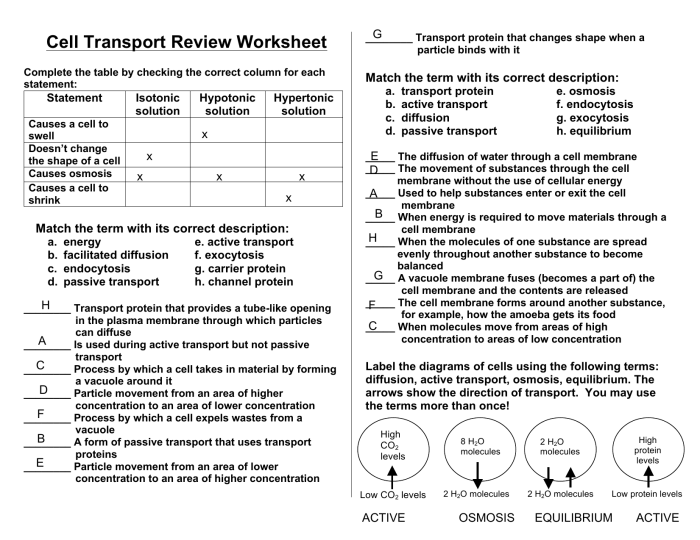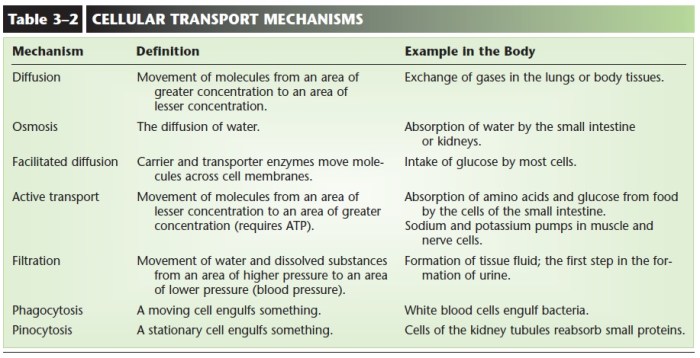Exercise 5 review sheet the cell transport mechanisms and permeability – Embarking on an exploration of Exercise 5’s review sheet on cell transport mechanisms and permeability, we delve into a realm of fundamental biological processes that orchestrate the delicate balance within living cells. This comprehensive analysis will illuminate the intricate mechanisms governing the movement of substances across cellular membranes, shaping cellular homeostasis and driving a myriad of vital functions.
From passive transport’s effortless diffusion to the energy-driven active transport and the facilitated diffusion’s selective passage, we unravel the diverse strategies employed by cells to regulate the influx and efflux of molecules. Factors such as concentration gradients, membrane permeability, and the presence of transport proteins emerge as key determinants of these transport processes.
Introduction

Cell transport mechanisms and permeability are crucial for maintaining cellular homeostasis and various biological processes. They allow cells to exchange essential substances with their surroundings, facilitating nutrient uptake, waste removal, and signal transduction.
Types of Cell Transport Mechanisms: Exercise 5 Review Sheet The Cell Transport Mechanisms And Permeability
Passive Transport
Passive transport involves the movement of substances across a cell membrane without the expenditure of energy. It occurs when there is a concentration gradient or electrochemical gradient across the membrane.
- Simple diffusion: Movement of small, nonpolar molecules across the lipid bilayer.
- Facilitated diffusion: Movement of polar or charged molecules across the membrane with the assistance of transport proteins.
- Osmosis: Movement of water across a semipermeable membrane from an area of low solute concentration to an area of high solute concentration.
Active Transport
Active transport requires energy (ATP) to move substances against their concentration gradient. It is mediated by transport proteins that bind to specific molecules and pump them across the membrane.
Facilitated Diffusion
Facilitated diffusion is a passive transport mechanism that utilizes transport proteins to increase the rate of movement of polar or charged molecules across the membrane. The transport proteins do not require energy.
Factors Affecting Cell Transport

Concentration Gradients
The difference in concentration between two areas drives the movement of substances across a membrane. A higher concentration gradient results in a faster rate of transport.
Membrane Permeability
The permeability of the cell membrane determines the ease with which substances can cross it. Factors such as lipid composition, protein channels, and membrane thickness affect permeability.
Presence of Transport Proteins
Transport proteins facilitate the movement of specific molecules across the membrane. Their presence increases the rate and specificity of transport.
Permeability of Cell Membranes
Cell membrane permeability refers to the ability of the membrane to allow substances to pass through it. Factors that affect permeability include:
- Lipid composition: The ratio of phospholipids to cholesterol affects membrane fluidity and permeability.
- Protein channels: Integral membrane proteins form channels that allow specific ions or molecules to cross the membrane.
- Membrane thickness: Thicker membranes are less permeable than thinner ones.
Importance of Cell Transport Mechanisms in Various Biological Processes
Nutrient Uptake
Cell transport mechanisms allow cells to take up essential nutrients from their surroundings, including glucose, amino acids, and ions.
Waste Removal
Cells use transport mechanisms to remove waste products, such as carbon dioxide and urea, from the cell.
Signal Transduction
Cell transport mechanisms are involved in signal transduction, allowing cells to receive and respond to external signals.
Cell Division, Exercise 5 review sheet the cell transport mechanisms and permeability
Cell transport mechanisms are essential for cell division, as they facilitate the movement of materials between the dividing cells.
Disorders Related to Cell Transport Mechanisms

Cystic Fibrosis
Cystic fibrosis is a genetic disorder caused by a defect in the CFTR protein, which is a chloride channel. This leads to impaired chloride transport and thick, sticky mucus in the lungs and other organs.
Sickle Cell Anemia
Sickle cell anemia is a genetic disorder caused by a mutation in the hemoglobin gene. This results in the production of abnormal hemoglobin molecules that can form rigid, sickle-shaped red blood cells, which can block blood vessels and cause various complications.
Essential Questionnaire
What is the significance of cell transport mechanisms?
Cell transport mechanisms are crucial for maintaining cellular homeostasis, facilitating the exchange of nutrients, waste products, and signaling molecules across cell membranes.
How does membrane permeability affect cell transport?
Membrane permeability, influenced by factors like lipid composition and protein channels, determines the ease with which substances can cross the membrane, impacting the rate and direction of cell transport.
What are some examples of disorders related to cell transport mechanisms?
Defects in cell transport mechanisms can lead to disorders such as cystic fibrosis, characterized by impaired chloride transport, and sickle cell anemia, resulting from abnormal hemoglobin transport.